Enantiomeric Separation and Molecular Modelling of Bioactive 4-Aryl-3,4-dihydropyrimidin-2(1H)-one Ester Derivatives on Teicoplanin-Based Chiral Stationary Phase
Abstract
:1. Introduction
2. Materials and Methods
2.1. Chemicals
2.2. Chromatography
2.3. X-ray Crystallography
2.4. Molecular Docking and Molecular Dynamics Calculations
3. Results and Discussion
3.1. Chiral Separation with Pirkle-Type Chiral Stationary Phases (CSPs)
3.2. Chiral Separation with Teicoplanin Aglycone Selector
3.3. Molecular Dockings of Selectands
3.4. Structural Interpretation of the Chiral Separation
4. Conclusions
Supplementary Materials
Author Contributions
Funding
Institutional Review Board Statement
Informed Consent Statement
Data Availability Statement
Acknowledgments
Conflicts of Interest
Abbreviations
References
- Calcaterra, A.; D’Acquarica, I. The market of chiral drugs: Chiral switches versus de novo enantiomerically pure compounds. J. Pharm. Biomed. Anal. 2018, 14, 7323–7340. [Google Scholar] [CrossRef]
- Kappe, C.O. Biologically active dihydropyrimidones of the Biginelli-type: A literature survey. Eur. J. Med. Chem. 2000, 35, 1043–1052. [Google Scholar] [CrossRef]
- Kappe, C.O. Recent Advances in the Biginelli dihydropyrimidine synthesis. New tricks from an old dog. Acc. Chem. Res. 2000, 33, 879–888. [Google Scholar] [CrossRef] [PubMed]
- Zhu, J.; Bienayme, H. Asymmetric isocyanide-based MCRs. In Multicomponent Reactions, 1st ed.; Wiley-VCH: Weinheim, Germany, 2005. [Google Scholar]
- Crespo, A.; El Maatougui, A.; Biagini, P.; Azuaje, J.; Coelho, A.; Brea, J.; Loza, M.I.; Cadavid, M.I.; García-Mera, X.; Gutieŕrez-de-Terań, H.; et al. Discovery of 3,4-dihydropyrimidin-2(1H)-ones as a novel class of potent and selective A2B adenosine receptor antagonists. ACS Med. Chem. Lett. 2013, 4, 1031–1036. [Google Scholar] [CrossRef] [PubMed] [Green Version]
- Carbajales, C.; Azuaje, J.; Oliveira, A.; Loza, M.I.; Brea, J.; Cadavid, M.I.; Masaguer, C.F.; García-Mera, X.; Gutiérrez de Terán, H.; Sotelo, E. Enantiospecific recognition at the A2B adenosine receptor by alkyl 2-cyanoimino-4-substituted-6-methyl-1,2,3,4-tetrahydropyrimidine-5-carboxylates. J. Med. Chem. 2017, 60, 3372–3382. [Google Scholar] [CrossRef]
- Crespo, A.; El Maatougui, A.; Azuaje, J.; Escalante, L.; Majellaro, M.; Loza, M.I.; Brea, J.; Cadavid, M.I.; Gutiérrez de Terán, H.; Sotelo, E. Exploring the influence of the substituent at position 4 in a series of 3,4-dihydropyrimidin-2(1H)-one A2B adenosine receptor antagonists. Chem. Heterocycl. Compd. 2017, 53, 316–322. [Google Scholar] [CrossRef]
- Mallo-Abreu, A.; Majellaro, M.; Jespers, W.; Azuaje, J.; Caamaño, O.; García-Mera, X.; Brea, J.M.; Loza, M.I.; Gutiérrez-De-Terán, H.; Sotelo, E. Trifluorinated pyrimidine-based A2B antagonists: Optimization and evidence of stereospecific recognition. J. Med. Chem. 2019, 62, 9315–9330. [Google Scholar] [CrossRef] [PubMed]
- El Maatougui, A.; Azuaje, J.; González-Gómez, M.; Miguez, G.; Crespo, A.; Carbajales, C.; Escalante, L.; García-Mera, X.; Gutiérrez de Terán, H.; Sotelo, E. Discovery of potent and highly selective A2B adenosine receptor antagonist chemotypes. J. Med. Chem. 2016, 59, 1967–1983. [Google Scholar] [CrossRef]
- Mallo-Abreu, A.; Prieto-Díaz, R.; Jespers, W.; Azuaje, J.; Majellaro, M.; Velando, C.; García-Mera, X.; Caamaño, O.; Brea, J.; Loza, M.I.; et al. Nitrogen-Walk Approach to Explore Bioisosteric Replacements in a Series of Potent A2B Adenosine Receptor Antagonists. J. Med. Chem. 2020, 63, 7721–7739. [Google Scholar] [CrossRef]
- Majellaro, M.; Jespers, W.; Crespo, A.; Núñez, M.J.; Novio, S.; Azuaje, J.; Prieto-Díaz, R.; Gioé, C.; Alispahic, B.; Brea, J.; et al. 3,4-Dihydropyrimidin-2(1H)-ones as Antagonists of the Human A2B Adenosine Receptor: Optimization, Structure–Activity Relationship Studies, and Enantiospecific Recognition. J. Med. Chem. 2021, 64, 458–480. [Google Scholar] [CrossRef]
- Kappe, C.O.; Stadler, A. The Biginelli dihydropyrimidinone synthesis. Org. React. 2004, 63, 1–116. [Google Scholar] [CrossRef]
- Bhosale, R.S.; Wang, T.; Zubaidha, P.K. An efficient, high yield protocol for the one-pot synthesis of dihydropyrimidin-2(1H)-ones catalyzed by iodine. Tetrahedron Lett. 2004, 45, 9111–9113. [Google Scholar] [CrossRef]
- Reddy, K.R.; Reddy, C.V.; Mahesh, M.; Raju, P.V.K.; Narayana Reddy, V.V. New environmentally friendly solvent free synthesis of dihydropyrimidinones catalysed by N-butyl-N,N-dimethyl-α-phenylethylammonium bromide. Tetrahedron Lett. 2003, 44, 8173–8175. [Google Scholar] [CrossRef]
- Balalaie, S.; Soleiman-Beigia, M.; Romingerb, F. Novel one-pot synthesis of new derivatives of dihydropyrimidinones and unusual polysubstituted imidazolin-2-ones: X-ray crystallographic structure. J. Iran. Chem. Soc. 2005, 2, 319–329. [Google Scholar] [CrossRef]
- Berthod, A.; Chen, X.; Kullman, J.P.; Armstrong, D.W.; Gasparrini, F.; D’Acquarica, I.; Villani, C.; Carotti, A. Role of the Carbohydrate Moieties in Chiral Recognition on Teicoplanin-Based LC Stationary Phases. Anal. Chem. 2000, 72, 1767–1780. [Google Scholar] [CrossRef] [PubMed]
- Jandera, P. Comparison of various modes and phase systems for analytical HPLC. In Separations Methods in Drug Synthesis and Purification; Valkò, K., Ed.; Elsevier: Amsterdam, The Netherlands, 2000; pp. 1–71. [Google Scholar]
- Péter, A.; Arki, A.; Tourwé, D.; Forró, E.; Fülöp, F.; Armstrong, D.W. Comparison of the separation efficiencies of chirobiotic T and TAG columns in the separation of unusual amino acids. J. Chromatogr. A 2004, 1031, 159–170. [Google Scholar] [CrossRef] [PubMed]
- Berthod, A.; Xiao, T.L.; Liu, Y.; McCulla, R.D.; Jenks, W.S.; Armstrong, D.W. Separation of chiral sulfoxides by liquid chromatography using macrocyclic glycopeptide chiral stationary phases. J. Chromatogr. A 2002, 955, 53–69. [Google Scholar] [CrossRef]
- Altomare, C.; Carotti, A.; Cellamare, S.; Fanelli, F.; Gasparrini, F.; Villani, C.; Carrupt, P.; Testa, B. Enantiomeric resolution of sulfoxides on a DACH-CNB chiral stationary phase: A quantitative structure-enantioselective retention relationship (QSERR) study. Chirality 1993, 5, 527–537. [Google Scholar] [CrossRef]
- Meričko, D.; Lehotay, J.; Armstrong, D.W. Effect of temperature on retention and enantiomeric separation of chiral sulfoxides using teicoplanin aglycone chiral stationary phase. J. Liq. Chromatogr. Relat. Technol. 2006, 29, 623–638. [Google Scholar] [CrossRef]
- Ravichandrana, S.; Collins, J.R.; Singh, N.; Wainer, I.W. A molecular model of the enantioselective liquid chromatographic separation of (R,S)-ifosfamide and its N-dechloroethylated metabolites on a teicoplanin aglycon chiral stationary phase. J. Chromatogr. A 2012, 1269, 218–225. [Google Scholar] [CrossRef] [Green Version]
- Pisani, L.; Rullo, M.; Catto, M.; de Candia, M.; Carrieri, A.; Cellamare, S.; Altomare, C. Structure-property relationship study of the HPLC enantioselective retention of neuroprotective 7-[(1-alkylpiperidin-3-yl) methoxy]coumarin derivatives on an amylose-based chiral stationary phase. J. Sep. Sci. 2018, 41, 1376–1384. [Google Scholar] [CrossRef]
- Kabsch, W. XDS. Acta Cryst. 2010, D66, 125–132. [Google Scholar] [CrossRef] [Green Version]
- Winn, M.D.; Ballard, C.C.; Cowtan, K.D.; Dodson, E.J.; Emsley, P.; Evans, P.R.; Keegan, R.M.; Krissinel, E.B.; Leslie, A.G.; McCoy, A.; et al. Overview of the CCP4 suite and current developments. Acta Cryst. 2011, D67, 235–242. [Google Scholar]
- Burla, M.C.; Caliandro, R.; Carrozzini, B.; Cascarano, G.L.; Cuocci, C.; Giacovazzo, C.; Mallamo, M.; Mazzone, A.; Polidori, G. Crystal structure determination and refinement via SIR2014. J. Appl. Cryst. 2015, 48, 306–309. [Google Scholar] [CrossRef]
- Sheldrick, G.M. Crystal structure refinement with SHELXL. Acta Crystallogr. 2015, C71, 3–8. [Google Scholar]
- Emsley, P.; Cowtan, K. Coot: Model-building tools for molecular graphics. Acta Cryst. 2004, D60, 2126–2132. [Google Scholar] [CrossRef] [Green Version]
- Murshudov, G.N.; Vagin, A.A.; Dodson, E.J. Refinement of macromolecular structures by the maximum-likelihood method. Acta Cryst. 1997, D53, 240–255. [Google Scholar] [CrossRef] [PubMed]
- Schrödinger Release 2020-4, Maestro, Schrödinger, LLC: New York, NY, USA, 2020.
- O’Boyle, N.M.; Banck, M.; James, C.A.; Morley, C.; Vandermeersch, T.; Hutchison, G.R. Open Babel: An open chemical toolbox. J. Cheminf. 2021, 3, 33. [Google Scholar] [CrossRef] [PubMed] [Green Version]
- QUACPAC 2.1.0.4, OpenEye Scientific Software: Santa Fe, MX, USA. Available online: http://www.eyesopen.com(accessed on 21 December 2021).
- Morris, G.M.; Goodsell, D.S.; Halliday, R.S.; Huey, R.; Hart, W.E.; Belew, R.K.; Olson, A.J. Automated docking using a Lamarckian genetic algorithm and an empirical binding free energy function. J. Comput. Chem. 1998, 19, 1639–1662. [Google Scholar] [CrossRef] [Green Version]
- Santos-Martins, D.; Solis-Vasquez, L.; Tillack, A.F.; Sanner, M.F.; Koch, A.; Forli, S. Accelerating AutoDock4 with GPUs and Gradient-Based Local Search. J. Chem. Theory Comput. 2021, 17, 1060–1073. [Google Scholar] [CrossRef] [PubMed]
- Bowers, K.J.; Chow, E.; Xu, H.; Dror, R.O.; Eastwood, M.P.; Gregersen, B.A.; Klepeis, J.L.; Kolossvary, I.; Moraes, M.A.; Sacerdoti, F.D.; et al. Scalable Algorithms for Molecular Dynamics Simulations on Commodity Clusters. In Proceedings of the ACM/IEEE Conference on Supercomputing (SC06), Tampa, FL, USA, 11–17 November 2006. [Google Scholar]
- Maestro-Desmond Interoperability Tools, Schrödinger: New York, NY, USA, 2020.
- Caliandro, R.; Belviso, B.D. RootProf: Software for multivariate analysis of unidimensional profiles. J. Appl. Cryst. 2014, 47, 1087–1096. [Google Scholar] [CrossRef]
- Humphrey, W.; Dalke, A.; Schulte, K. VMD: Visual molecular dynamics. J. Mol. Graph. 1996, 14, 33–38. [Google Scholar] [CrossRef]
- Forjan, D.M.; Gazic, I.; Vinkovic, V. Role of the weak interactions in enantiorecognition of racemic dihydropyrimidinones by novel Brush-type chiral stationary phases. Chirality 2000, 19, 446–452. [Google Scholar] [CrossRef] [PubMed]
- Fernandes, C.; Tiritan, M.E.; Cass, Q.; Kairys, V.; Fernandes, M.X.; Pinto, M. Enantioseparation and chiral recognition mechanism of new chiral derivatives of xanthones on macrocyclic antibiotic stationary phases. J. Chromatogr. A 2012, 1241, 60–68. [Google Scholar] [CrossRef] [PubMed]
- Zhou, P.; Tian, F.; Lv, F.; Shang, Z. Geometric characteristics of hydrogen bonds involving sulfur atoms in proteins. Proteins 2009, 76, 151–163. [Google Scholar] [CrossRef] [PubMed]
- Slama, I.; Ravelet, C.; Villet, A.; Ravel, A.; Grosset, C.; Peyrin, E. Displacement study on a vancomycin-based stationary phase using N-acetyl-D-Alanine as a Competing Agent. J. Chromatogr. Sci. 2002, 40, 83–86. [Google Scholar] [CrossRef] [PubMed] [Green Version]
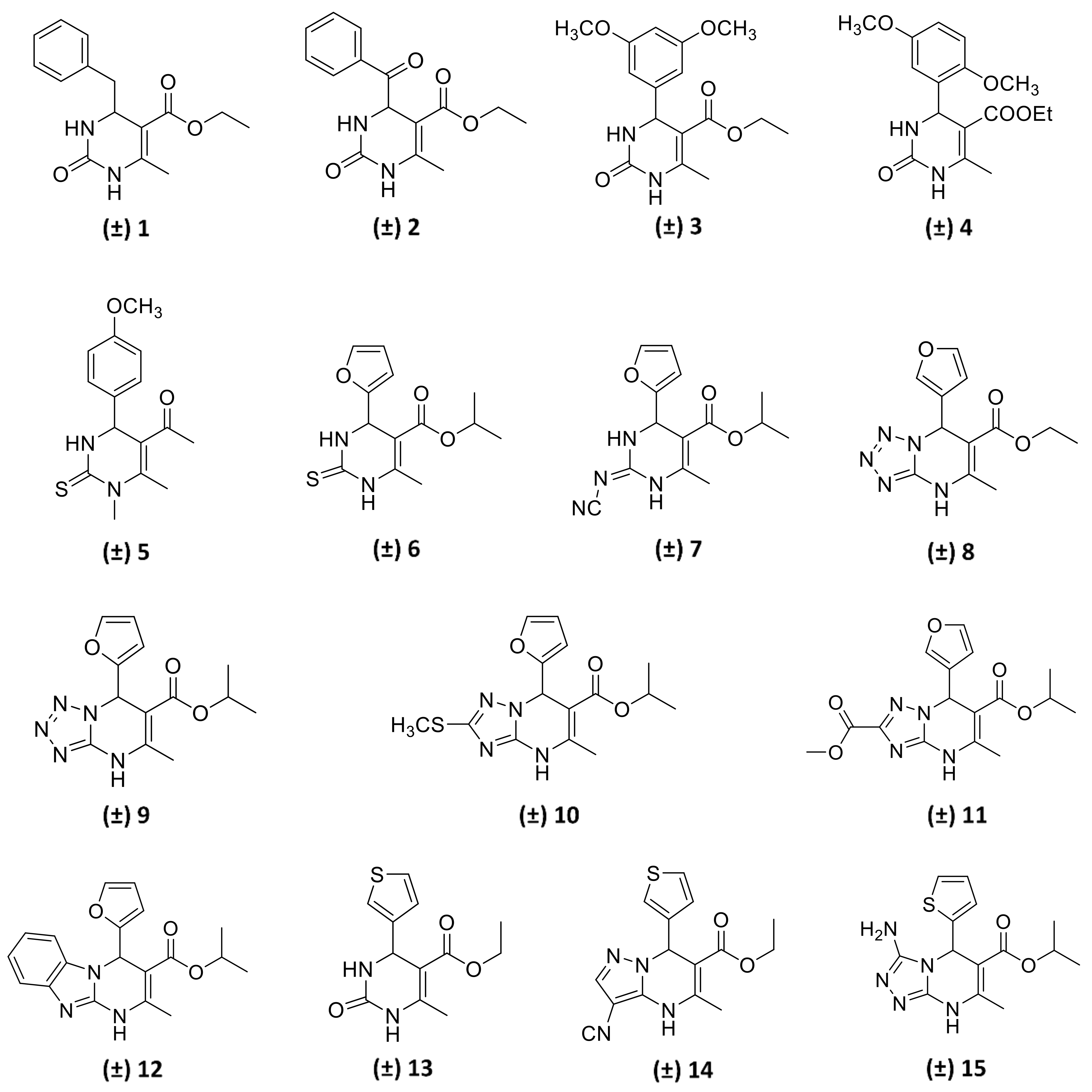
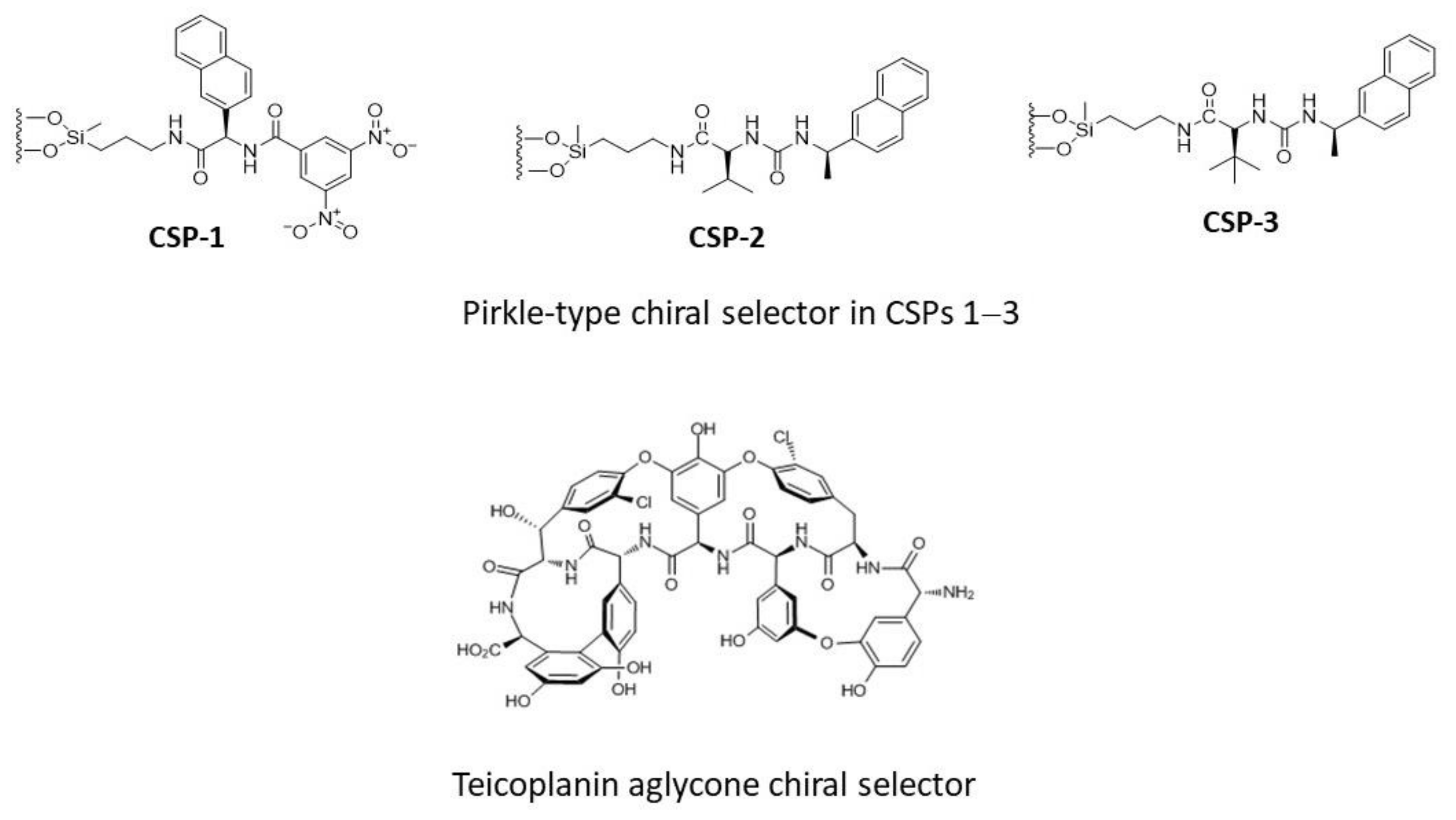

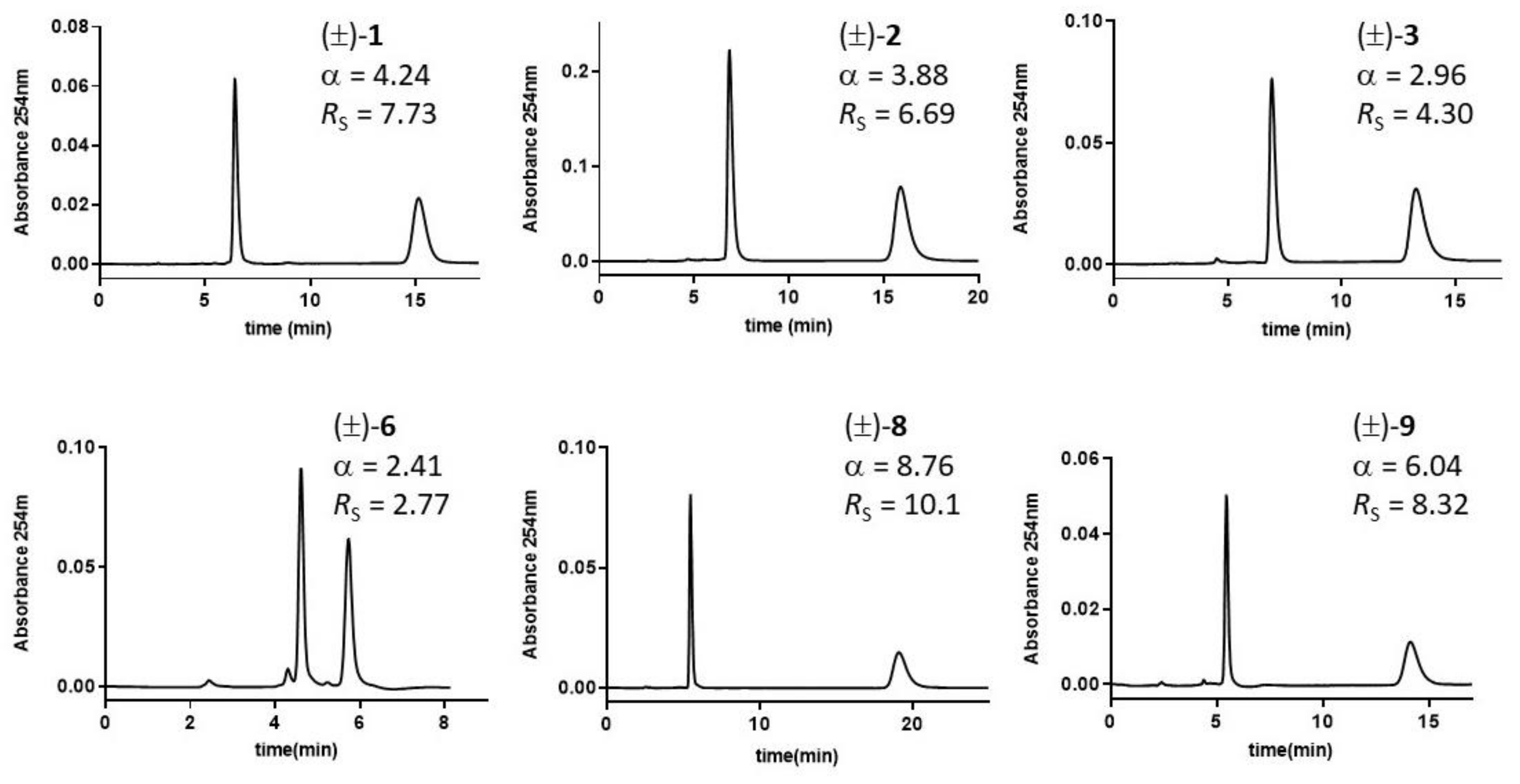
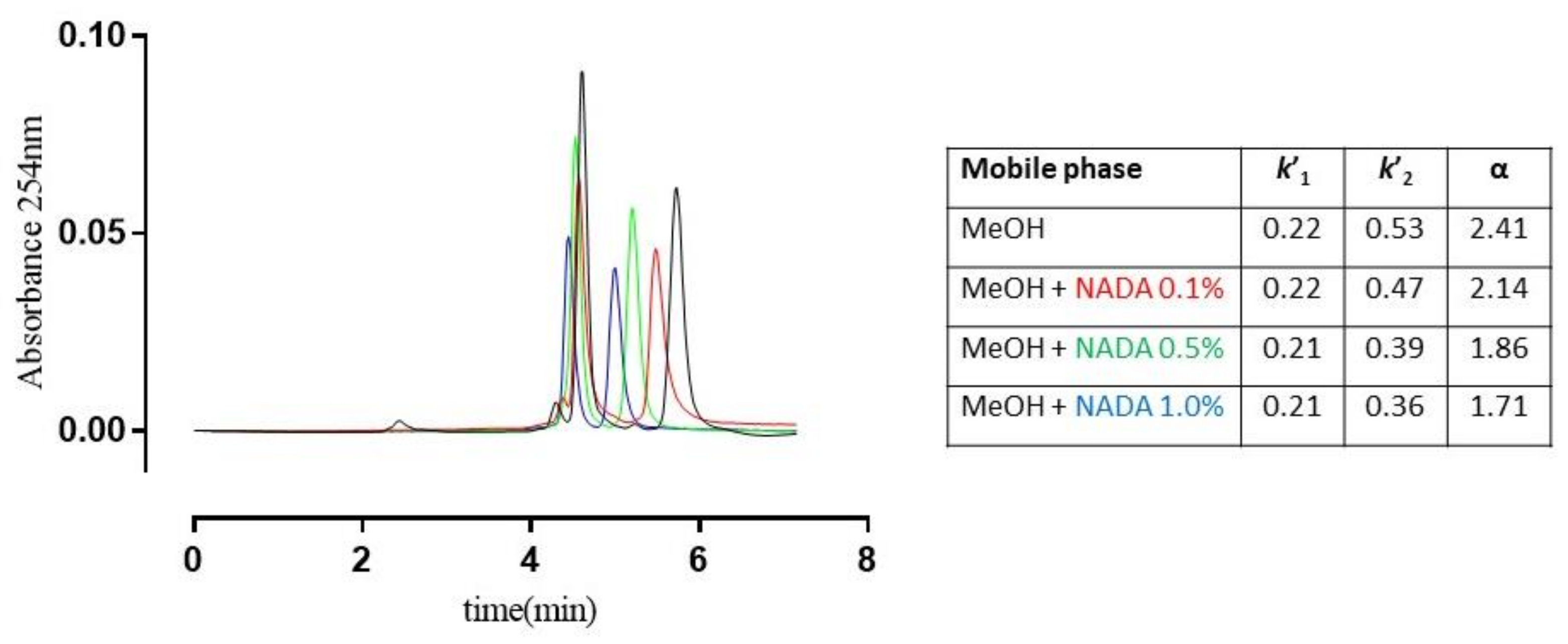
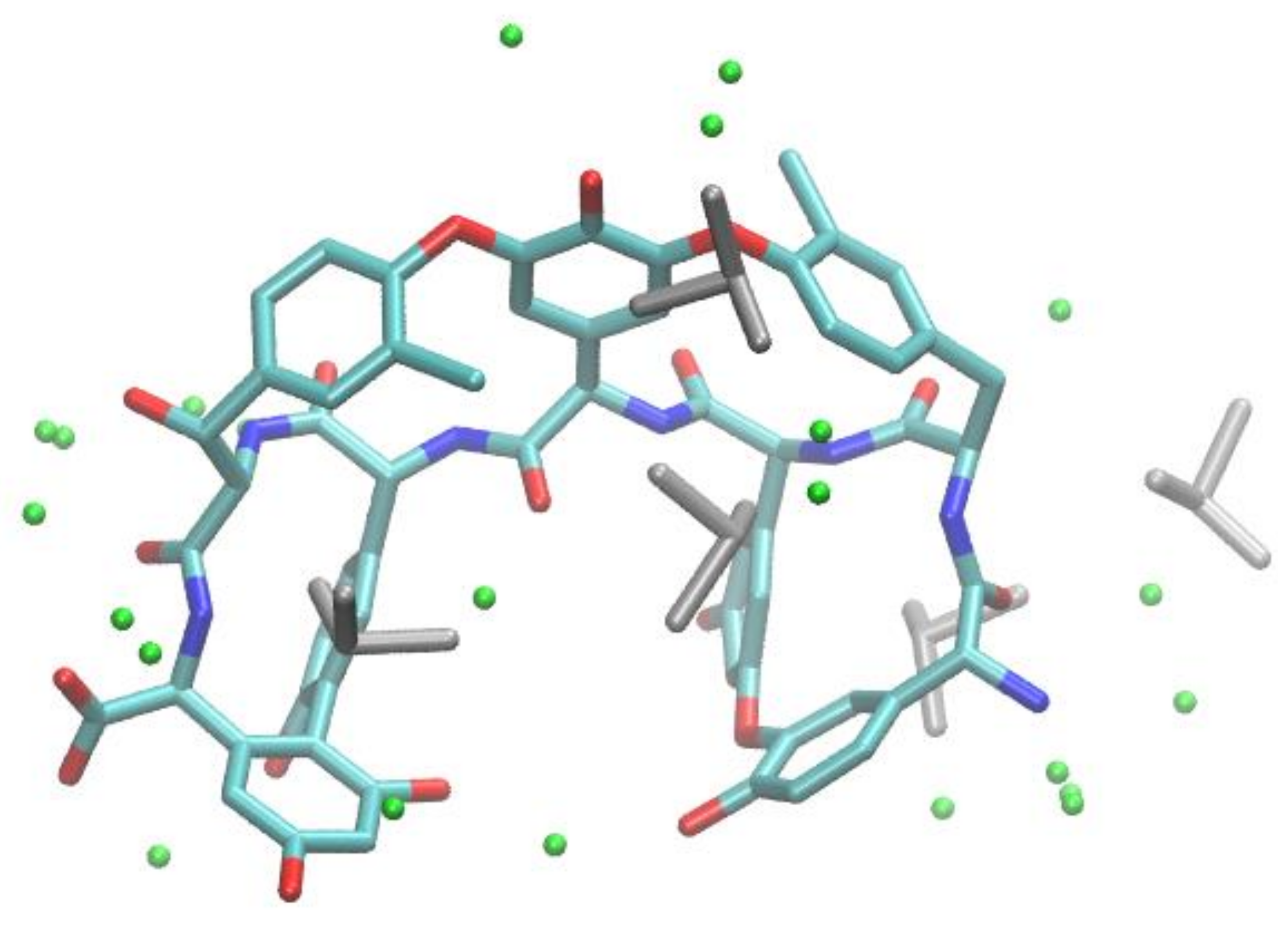


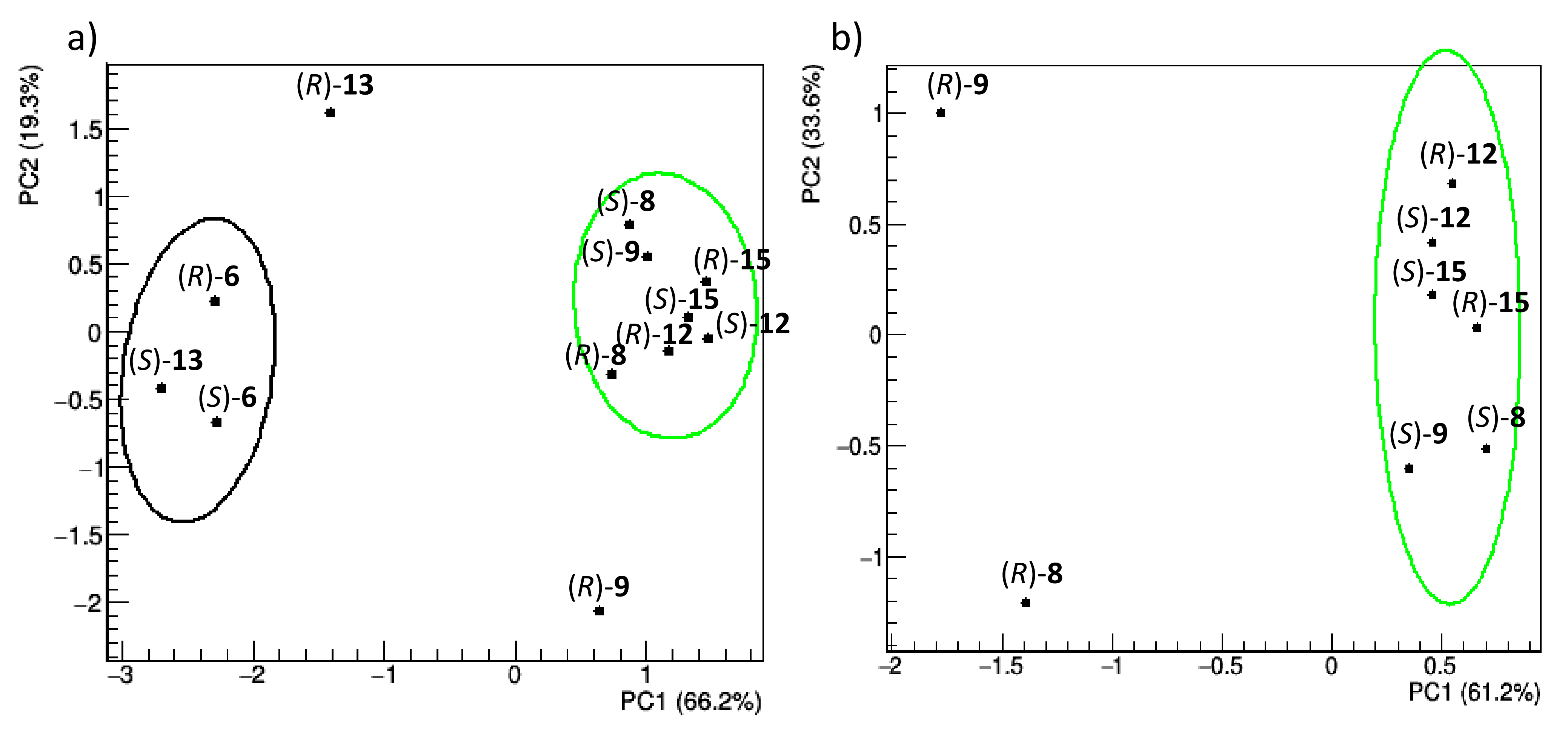
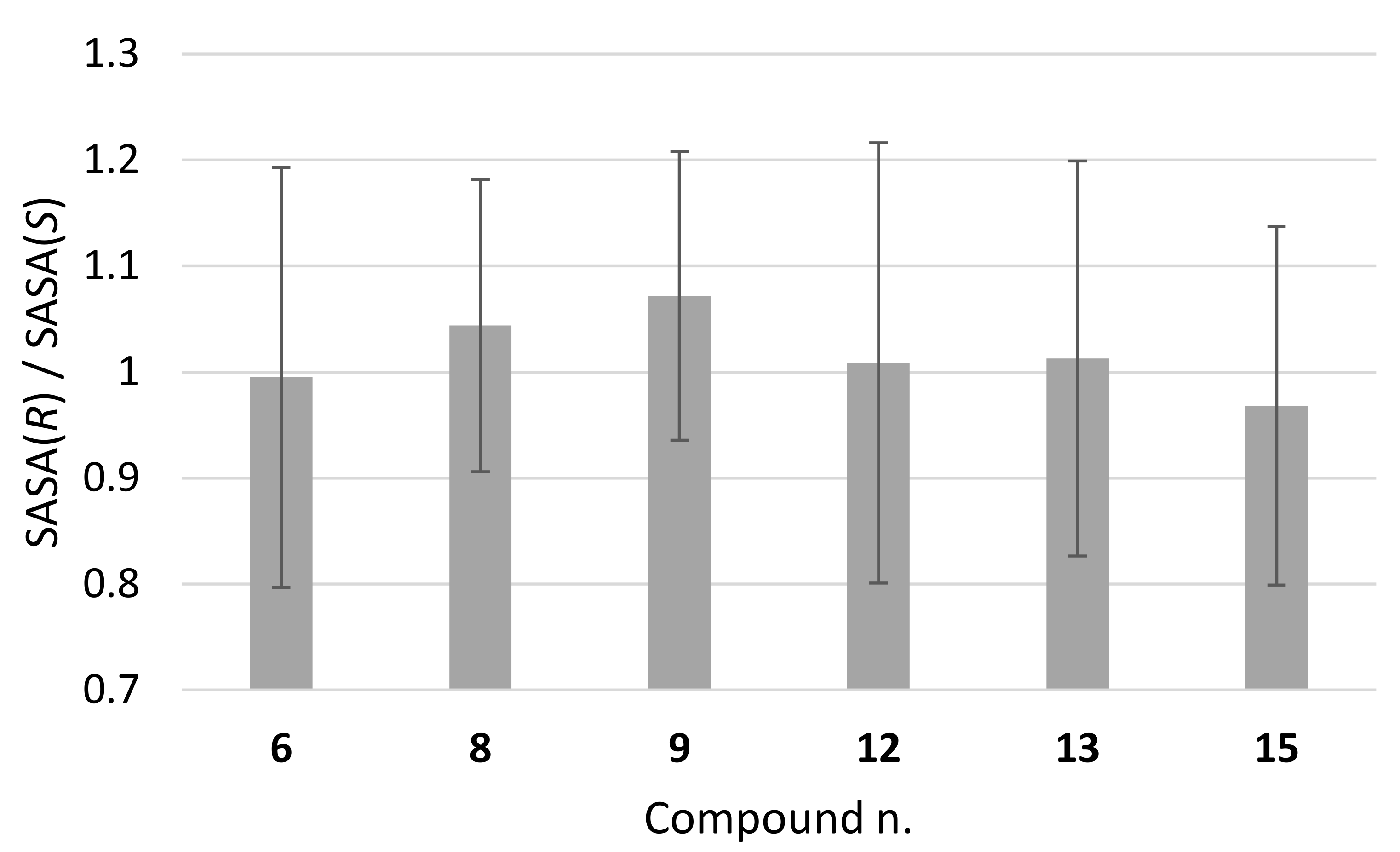
| Analyte | CSP 1 | CSP 2 | CSP 3 | |||
|---|---|---|---|---|---|---|
| k1 | α | k1 | α | k1 | α | |
| 1 | 5.07 | 1 | 2.51 | 1.15 | 2.38 | 1.17 |
| 2 | 23.0 | 1.09 | 11.0 | 1.11 | 10.4 | 1.09 |
| 3 | 19.9 | 1.23 | 7.70 | 1 | 6.67 | 1.06 |
| 4 | 15.7 | 1.21 | 5.61 | 1 | 4.86 | 1.06 |
| 5 | 23.5 | 1 | 20.3 | 1 | 22.6 | 1 |
| 6 | 8.22 | 1.09 | 5.06 | 1.22 | 4.24 | 1.27 |
| 7 | 11.5 | 1 | 11.2 | 1.05 | 6.13 | 1.11 |
| 8 | 6.97 | 1.08 | 5.34 | 1.06 | 3.85 | 1.12 |
| 9 | 6.92 | 1.08 | 6.17 | 1.07 | 4.34 | 1.09 |
| 10 | 2.00 | 1 | 0.93 | 1.43 | 1.06 | 1.43 |
| 11 | 11.0 | 1.40 | 4.37 | 1.24 | 4.27 | 1.38 |
| 12 | 2.25 | 1.22 | 0.98 | 1.39 | 0.99 | 1.51 |
| 13 | 11.5 | 1.12 | 7.08 | 1.08 | 6.62 | 1.13 |
| 14 | 5.82 | 1.17 | 2.19 | 1 | 1.62 | 1 |
| 15 | 17.03 | 1 | 5.66 | 1.1 | 4.59 | 1.18 |
| Analyte | A | B | C | |||
|---|---|---|---|---|---|---|
| k1 | α | k1 | α | k1 | α | |
| 1 | 0.72 | 4.24 | 2.13 | 4.00 | 0.66 | 2.65 |
| 2 | 0.84 | 3.88 | 2.46 | 2.75 | 0.64 | 2.55 |
| 3 | 0.86 | 2.96 | 2.40 | 2.42 | 0.61 | 2.90 |
| 4 | 0.89 | 1.61 | 2.17 | 1.58 | 0.61 | 1.46 |
| 5 | 0.73 | 1 | 1.9 | 1 | 0.63 | 1 |
| 6 | 0.22 | 2.41 | 0.50 | 2.12 | 0.14 | 1.64 |
| 7 | 0.32 | 2.00 | 0.56 | 2.28 | 0.31 | 1.32 |
| 8 | 0.47 | 8.76 | 0.85 | 9.68 | 0.26 | 4.77 |
| 9 | 0.46 | 6.04 | 0.94 | 5.52 | 0.21 | 3.67 |
| 10 | 0.27 | 1 | 0.37 | 1 | 0.24 | 1 |
| 11 | 0.46 | 1.50 | 0.94 | 1.45 | 0.18 | 1.11 |
| 12 | 0.35 | 1 | 0.52 | 1 | 0.30 | 1 |
| 13 | 0.79 | 1 | 2.32 | 1 | 0.66 | 1 |
| 14 | 0.28 | 1 | 0.41 | 1 | 0.15 | 1 |
| 15 | 0.40 | 1 | 0.75 | 1 | 0.38 | 1 |
| cmpd | Chirality | FEB | EFF a | VdW + HB + ELE + DES a | VdW + HB a | ELE a | DES a |
|---|---|---|---|---|---|---|---|
| 6 | R | −6.80 | −0.296 | −7.08 | −8.87 | 0.02 | 1.78 |
| S | −7.55 | −0.328 | −7.60 | −9.82 | 0.04 | 2.19 | |
| 8 | R | −6.74 | −0.337 | −7.13 | −9.03 | −0.12 | 2.02 |
| S | −6.68 | −0.334 | −7.07 | −8.96 | −0.05 | 1.94 | |
| 9 | R | −7.39 | −0.352 | −7.40 | −9.29 | −0.05 | 1.93 |
| S | −7.36 | −0.350 | −7.51 | −9.43 | −0.14 | 2.06 | |
| 12 | R | −7.56 | −0.302 | −7.38 | −9.46 | −0.25 | 2.33 |
| S | −7.16 | −0.286 | −7.10 | −9.28 | −0.26 | 2.44 |
Publisher’s Note: MDPI stays neutral with regard to jurisdictional claims in published maps and institutional affiliations. |
© 2021 by the authors. Licensee MDPI, Basel, Switzerland. This article is an open access article distributed under the terms and conditions of the Creative Commons Attribution (CC BY) license (https://creativecommons.org/licenses/by/4.0/).
Share and Cite
Bolognino, I.; Carrieri, A.; Purgatorio, R.; Catto, M.; Caliandro, R.; Carrozzini, B.; Belviso, B.D.; Majellaro, M.; Sotelo, E.; Cellamare, S.; et al. Enantiomeric Separation and Molecular Modelling of Bioactive 4-Aryl-3,4-dihydropyrimidin-2(1H)-one Ester Derivatives on Teicoplanin-Based Chiral Stationary Phase. Separations 2022, 9, 7. https://doi.org/10.3390/separations9010007
Bolognino I, Carrieri A, Purgatorio R, Catto M, Caliandro R, Carrozzini B, Belviso BD, Majellaro M, Sotelo E, Cellamare S, et al. Enantiomeric Separation and Molecular Modelling of Bioactive 4-Aryl-3,4-dihydropyrimidin-2(1H)-one Ester Derivatives on Teicoplanin-Based Chiral Stationary Phase. Separations. 2022; 9(1):7. https://doi.org/10.3390/separations9010007
Chicago/Turabian StyleBolognino, Isabella, Antonio Carrieri, Rosa Purgatorio, Marco Catto, Rocco Caliandro, Benedetta Carrozzini, Benny Danilo Belviso, Maria Majellaro, Eddy Sotelo, Saverio Cellamare, and et al. 2022. "Enantiomeric Separation and Molecular Modelling of Bioactive 4-Aryl-3,4-dihydropyrimidin-2(1H)-one Ester Derivatives on Teicoplanin-Based Chiral Stationary Phase" Separations 9, no. 1: 7. https://doi.org/10.3390/separations9010007
APA StyleBolognino, I., Carrieri, A., Purgatorio, R., Catto, M., Caliandro, R., Carrozzini, B., Belviso, B. D., Majellaro, M., Sotelo, E., Cellamare, S., & Altomare, C. D. (2022). Enantiomeric Separation and Molecular Modelling of Bioactive 4-Aryl-3,4-dihydropyrimidin-2(1H)-one Ester Derivatives on Teicoplanin-Based Chiral Stationary Phase. Separations, 9(1), 7. https://doi.org/10.3390/separations9010007












